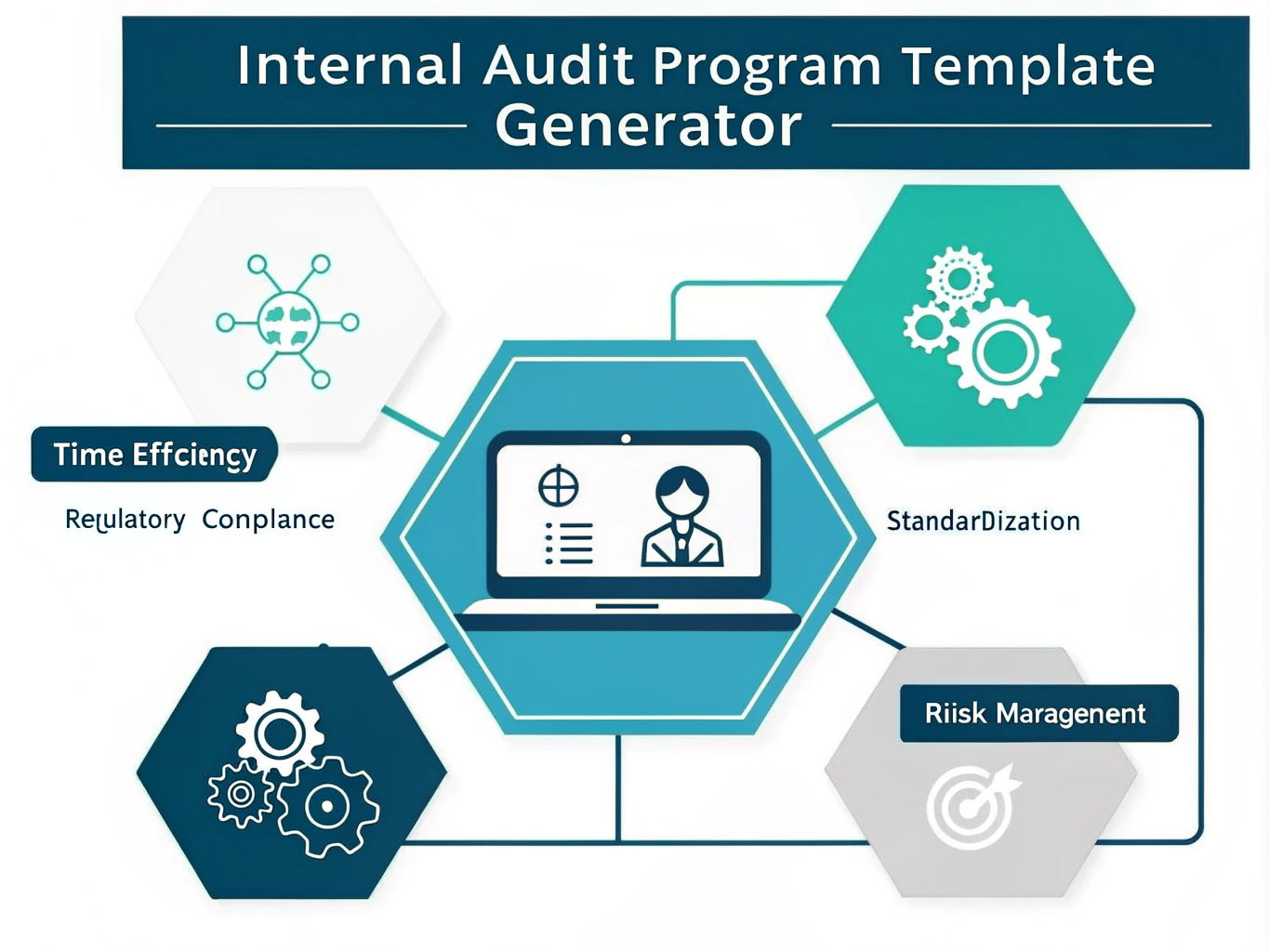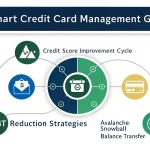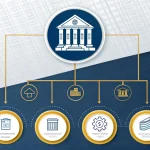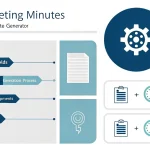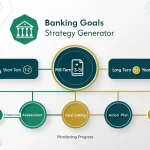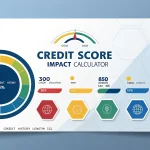Is this tool helpful?
How to Use the Internal Audit Program Template Generator Effectively
To make the most of this powerful Internal Audit Program Template Generator, follow these simple steps:
- Enter the Process Name: In the first field, input the specific process you want to audit. For example, you might enter “loan origination” or “customer onboarding.”
- Select the Industry Type: Choose the appropriate financial institution type from the dropdown menu: Banking, Credit Union, or Fintech.
- Add Regulatory Citations (Optional): If you have specific regulatory citations relevant to your audit, enter them in the designated field. For instance, you could input “12 CFR 1026.43, NCUA Part 723” for a mortgage lending audit.
- Provide Compliance Firm Name (Optional): If you’re creating a proposal document, enter your compliance and audit firm’s name, such as “Global Compliance Partners LLC.”
- Generate the Template: Click the “Generate Internal Audit Program Template” button to create your customized audit program.
- Review and Copy: Once generated, review the template and use the “Copy to Clipboard” button to easily transfer the content to your preferred document editor.
Revolutionizing Internal Audits: The Power of Automated Template Generation
In the fast-paced world of financial services, staying compliant and maintaining robust internal controls is paramount. Our Internal Audit Program Template Generator is a game-changing tool designed to streamline the audit process for banks, credit unions, and fintech firms. By automating the creation of comprehensive audit templates, this innovative solution empowers auditors, compliance officers, and risk management professionals to focus on what truly matters: identifying and mitigating risks.
The Evolution of Internal Auditing in Financial Services
Internal auditing has come a long way since its inception. From manual, paper-based processes to the digital age, the field has continuously adapted to meet the growing complexities of the financial sector. However, the increasing regulatory burden and the rapid pace of technological change have created new challenges for audit professionals.
Enter the Internal Audit Program Template Generator – a tool that bridges the gap between traditional auditing practices and the demands of modern financial institutions. By leveraging advanced algorithms and industry best practices, this generator produces tailored audit programs in a fraction of the time it would take to create them manually.
Key Components of a Robust Internal Audit Program
Our generator creates templates that include all the essential elements of a comprehensive internal audit program:
- Risk Control: Identifies and assesses key risk factors associated with the specified process.
- Inherent Risk: Evaluates the level of risk present without considering mitigating controls.
- Control Objective: Defines the desired outcome of implementing control measures.
- Testing Procedures: Outlines specific steps to evaluate the effectiveness of controls.
- Error Number and Rate: Tracks and quantifies identified issues during the audit process.
- Regulatory Citations: Links relevant regulatory requirements to audit procedures.
- Additional Notes: Provides space for auditors to include context-specific information.
Benefits of Using the Internal Audit Program Template Generator
1. Time and Resource Efficiency
One of the most significant advantages of using this tool is the substantial time savings it offers. What once took hours or even days to create can now be generated in minutes. This efficiency allows audit teams to allocate their resources more effectively, focusing on high-value activities such as risk analysis and control testing.
2. Consistency and Standardization
By using a template generator, organizations can ensure consistency across all their audit programs. This standardization not only improves the quality of audits but also facilitates easier review and comparison of results across different departments or time periods.
3. Customization and Flexibility
Despite its standardized approach, the generator offers a high degree of customization. By simply inputting the process name and industry type, users can create tailored audit programs that address the unique risks and regulatory requirements of their specific operations.
4. Regulatory Compliance
Staying compliant with ever-changing regulations is a constant challenge for financial institutions. This tool helps address this issue by incorporating relevant regulatory citations and guidelines into the audit program, ensuring that compliance requirements are always at the forefront of the audit process.
5. Enhanced Risk Management
By providing a structured approach to identifying and assessing risks, the template generator supports a more robust risk management framework. This proactive approach helps institutions identify potential issues before they become significant problems.
Addressing User Needs: Solving Audit and Compliance Challenges
The Internal Audit Program Template Generator addresses several key challenges faced by financial institutions in their audit and compliance efforts:
Challenge 1: Keeping Pace with Regulatory Changes
Financial regulations are constantly evolving, making it difficult for institutions to ensure their audit programs remain up-to-date and compliant.
Solution: The generator incorporates the latest regulatory requirements and allows for easy updates as regulations change. This ensures that audit programs always reflect the current regulatory landscape.
Challenge 2: Resource Constraints
Many financial institutions, especially smaller ones, struggle with limited resources for their audit and compliance functions.
Solution: By automating the template creation process, the generator significantly reduces the time and effort required to develop audit programs. This allows institutions to make the most of their limited resources and focus on critical audit activities.
Challenge 3: Inconsistency in Audit Approaches
Inconsistent audit methodologies across different departments or branches can lead to gaps in risk coverage and difficulties in comparing results.
Solution: The standardized approach provided by the template generator ensures consistency across all audit programs while still allowing for customization based on specific processes and risk factors.
Challenge 4: Difficulty in Demonstrating Regulatory Compliance
Financial institutions often struggle to clearly demonstrate their compliance efforts to regulators.
Solution: By incorporating regulatory citations and linking them directly to audit procedures, the generator creates a clear audit trail that helps institutions demonstrate their compliance efforts more effectively.
Practical Applications: Real-World Examples
To illustrate the versatility and effectiveness of the Internal Audit Program Template Generator, let’s explore some practical applications across different types of financial institutions:
Example 1: Commercial Bank – Loan Underwriting Process
A large commercial bank needs to audit its loan underwriting process to ensure compliance with regulatory requirements and internal policies.
Using the Generator:
- Process Name: “Commercial Loan Underwriting”
- Industry Type: Banking
- Regulatory Citations: “12 CFR 1026.43, 12 CFR 1003”
The generated template would include:
- Risk controls specific to loan underwriting, such as credit analysis procedures and approval hierarchies
- Testing procedures for verifying adherence to lending limits and documentation requirements
- Regulatory guidance on fair lending practices and HMDA reporting
Example 2: Credit Union – Member Services Operations
A mid-sized credit union wants to audit its member services operations to improve customer satisfaction and ensure compliance with NCUA regulations.
Using the Generator:
- Process Name: “Member Services Operations”
- Industry Type: Credit Union
- Regulatory Citations: “NCUA Part 701, NCUA Part 715”
The resulting template would cover:
- Risk assessment of member data protection measures
- Testing procedures for account opening and closing processes
- Compliance checks for disclosures and fee structures
Example 3: Fintech Company – Payment Processing System
A growing fintech company needs to audit its payment processing system to ensure security, efficiency, and compliance with relevant regulations.
Using the Generator:
- Process Name: “Payment Processing System”
- Industry Type: Fintech
- Regulatory Citations: “15 U.S.C. 1693 (EFTA), PCI DSS”
The generated template would include:
- Risk assessment of cybersecurity measures and fraud detection systems
- Testing procedures for transaction processing speed and accuracy
- Compliance checks for data protection and consumer disclosure requirements
Frequently Asked Questions (FAQ)
Q1: Can I use this template generator for any type of financial institution?
A1: Yes, the generator is designed to create audit templates for banks, credit unions, and fintech firms. Simply select the appropriate industry type when using the tool.
Q2: How often should I update my audit program templates?
A2: It’s recommended to review and update your audit program templates at least annually or whenever there are significant changes in regulations or your internal processes.
Q3: Can I customize the generated template further?
A3: Absolutely! The generated template provides a comprehensive starting point, but you can and should customize it further to meet your specific needs and risk profile.
Q4: Does the generator include all possible regulatory citations?
A4: While the generator includes many common regulatory citations, it’s always a good idea to consult with your compliance team or legal counsel to ensure all relevant regulations are covered.
Q5: How can I ensure the audit program is effective for my specific institution?
A5: While the generator provides a solid foundation, it’s important to tailor the program to your institution’s specific risks and control environment. Regularly review and update the program based on audit findings and changes in your business.
Q6: Can this tool help with creating audit reports?
A6: While the primary function is to generate audit program templates, the structured format can certainly aid in organizing and presenting audit findings in your reports.
Q7: Is there a way to track changes or versions of the audit programs?
A7: The generator itself doesn’t include version control, but we recommend implementing a version control system within your organization to track changes to audit programs over time.
Q8: How does this tool help with regulatory examinations?
A8: By providing a structured, comprehensive audit program that incorporates relevant regulatory citations, this tool can help demonstrate to examiners that your institution has a robust, risk-based approach to internal auditing.
Q9: Can I use this for creating proposal documents for clients?
A9: Yes, the tool includes an option to input your compliance firm’s name, which can be useful when creating proposal documents for potential clients.
Q10: How does the tool stay updated with new regulations?
A10: Our team regularly updates the tool to reflect new regulations. However, it’s always important to stay informed about regulatory changes in your specific area of operation.
By leveraging the power of the Internal Audit Program Template Generator, financial institutions can significantly enhance their audit and compliance efforts. This innovative tool not only saves time and resources but also ensures a comprehensive, consistent, and compliant approach to internal auditing. As the financial landscape continues to evolve, embracing such technological solutions will be crucial for institutions looking to maintain robust risk management practices and stay ahead of regulatory requirements.
Important Disclaimer
The calculations, results, and content provided by our tools are not guaranteed to be accurate, complete, or reliable. Users are responsible for verifying and interpreting the results. Our content and tools may contain errors, biases, or inconsistencies. We reserve the right to save inputs and outputs from our tools for the purposes of error debugging, bias identification, and performance improvement. External companies providing AI models used in our tools may also save and process data in accordance with their own policies. By using our tools, you consent to this data collection and processing. We reserve the right to limit the usage of our tools based on current usability factors. By using our tools, you acknowledge that you have read, understood, and agreed to this disclaimer. You accept the inherent risks and limitations associated with the use of our tools and services.
